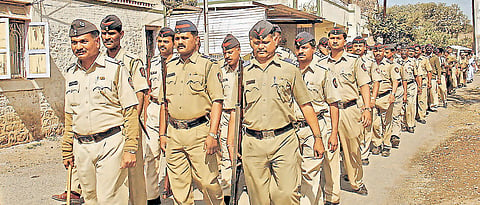

What exactly is our perception of police in India? One can safely say it is not positive. In the past, it primarily worked as the enforcement for British overlords. Now, like many other state organs, it remains riddled with corruption and political interference. One has to just take one look at the pathetic state of the police quarters to guess at least one compulsion behind the pervading graft culture. However, this is but one of the problems plaguing the critical cog in the law enforcement machine.
To start with, the force remains critically understaffed. In 2016, MoS Home affairs Hansraj Ahir told the Lok Sabha, quoting from a BPR&D report, that the ratio between the police and general public is 1: 720 whereas the sanctioned ratio is 1: 547, in the country. This deficiency especially comes to the fore during sensitive times like festivals, where the force has to undertake bandobast for as long as 24-48 hours without breaks.
Dr Meeran Chadha Borwankar, former Director General of Bureau of Police Research and Development (BPR&D) as well as former Director General, Legal and Technical, Maharashtra state, said, “Law and order duties and crime (investigation) police have not been separated as a result police is overburdened with ‘bandobast’ duties. Citizens do not get good quality investigation. Citizens must bring pressure on political leadership to separate these two duties. This is one basic reform that should be implemented urgently.”
The second biggest factor is political interference. How many time have we seen the corrupt neta-cop nexus in movies? It continues in real life, too. The Second Administrative Reforms Commission (2007) pointed out that this control has been abused. It is a very important question that needs to be faced. Yes, the police force needs to be answerable to someone, but at what stage does it stop being answerable and start becoming a puppet?
Prakash Singh, former DGP of Assam and Uttar Pradesh, Supreme Court had given landmark judgement on police reforms, said, “None of the states have fully implemented the recommendations of the SC. Not even the Central government who should have taken the lead in creating a model police force. Politicians don’t want to change the police system as they wait for the time when they will come to power and teach opposition leader a lesson, even knowing that he/she can also be in the opposition.”
This also segues into another critical factor: police-public interaction. The general tendency in India so far is to steer clear of two places: courts and police stations. Does the general public view the police as trustworthy? The answer may be a resounding NO.
Another key area is infrastructure. That our police force is not equipped with the latest equipment was cruelly brought to the spotlight during the 26/11 attacks. Urban crime is on the rise and police seems totally unequipped to deal with it.
The Supreme Court had 11 years back laid out seven directives to start the process of police reforms. However, the speed of implementation of the same seems to be glacial. Successive governments have hemmed and hawed, including the current one, which had included police reforms in their manifesto. Can we dare hope for a people-friendly police force?
Only superficial reforms done
† Former Director General of Police (special operations) Jayant Umranikar, who has authored a book, Police Reforms In India: A Sisyphean Saga, says, “In the last few years, there have been some superficial reforms. However, nobody is bothered about the functional autonomy of the police so that nobody interferes with their work. There should be enough funds and some planning (like 5 years plan). The municipal functions like traffic management and other non-essential duties should be taken away from the department, which is always short staffed. Also every state is having their own Police Act and they have put more control on the police instead of giving any autonomy. There are variations in every state police which may create problems in the future. The Central government has provided some funds for modernisation but its result will be seen only after few years.”
